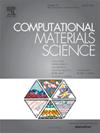Quantitative insights of competitive plastic deformation mechanisms in metastable β-Ti Alloys: integrated experimental observations and a first-principles approach
IF 3.1
3区 材料科学
Q2 MATERIALS SCIENCE, MULTIDISCIPLINARY
引用次数: 0
Abstract
Precise control of deformation mechanisms in metastable β-Titanium alloys is essential for optimizing their mechanical properties. While conventional semi-empirical d-electron theory offers qualitative predictions, it falls short in quantifying the influence of alloying elements on deformation pathways. This study investigates the competitive deformation mechanisms in a multicomponent Ti-8Mo-5 W-1Fe alloy using integrated experimental characterization and first-principles calculations. The addition of Fe suppresses the β → α’’ martensitic transformation during early-stage deformation (ε < 2 %), promoting {332}〈113〉β twinning as the dominant mechanism, coupled with SI-ω/α’ phase transformations (ε, 2–10 %). First-principles calculations, employing virtual crystal approximation and nudged elastic band methods, quantify these deformation modes’ energy profiles and driving forces. The results show that the β → α’’ transformation is driven by a smaller absolute energy difference (−44 meV/atom) in Ti-8Mo-5 W-1Fe compared to Ti-12Mo (−92 meV/atom) and Ti-9Mo-6 W (−56 meV/atom). Conversely, SI-ω/α’ transformations have the highest energy difference (−107 meV/atom and −93 meV/atom) in the ternary alloy. Formation energy analysis further reveals that reduced Mo and increased W content thermodynamically favor ω phase and α’ martensite formation. The delayed α’’ formation and preferential activation of twinning and SI-ω/α’ mechanisms enhance strain hardening in Ti-8Mo-5 W-1Fe, sustaining a high hardening rate (>2 GPa) up to 15 % strain while maintaining an excellent strength-ductility balance. This study provides a quantitative framework for alloy design, advancing the understanding of deformation mechanisms in metastable β-Ti alloys beyond traditional semi-empirical approaches.

亚稳β-钛合金竞争性塑性变形机制的定量分析:综合实验观察和第一性原理方法
精确控制亚稳态β-钛合金的变形机制是优化其力学性能的关键。虽然传统的半经验d电子理论提供了定性预测,但它在量化合金元素对变形路径的影响方面存在不足。本研究采用综合实验表征和第一性原理计算研究了多组分ti - 8mo - 5w - 1fe合金的竞争变形机制。Fe的加入抑制了早期变形过程中β→α”马氏体相变(ε <;2%),促进{332}< 113 > β孪晶为主要机制,并伴有SI-ω/α′相变(ε, 2 - 10%)。第一性原理计算,采用虚拟晶体近似和轻推弹性带方法,量化了这些变形模式的能量分布和驱动力。结果表明,与Ti-12Mo (- 92 meV/原子)和Ti-9Mo-6 W (- 56 meV/原子)相比,Ti-8Mo-5 W- 1fe的β→α”转变是由较小的绝对能量差(- 44 meV/原子)驱动的。相反,SI-ω/α′相变在三元合金中具有最大的能量差(- 107 meV/原子和- 93 meV/原子)。生成能分析进一步表明,Mo含量的降低和W含量的增加有利于ω相和α′马氏体的形成。α”的延迟形成和孪晶的优先激活以及SI-ω/α”机制增强了Ti-8Mo-5 W-1Fe的应变硬化,在保持良好的强度-塑性平衡的同时,保持高达15%应变的高硬化速率(>2 GPa)。这项研究为合金设计提供了一个定量框架,超越了传统的半经验方法,促进了对亚稳β-钛合金变形机制的理解。
本文章由计算机程序翻译,如有差异,请以英文原文为准。
求助全文
约1分钟内获得全文
求助全文
来源期刊

Computational Materials Science
工程技术-材料科学:综合
CiteScore
6.50
自引率
6.10%
发文量
665
审稿时长
26 days
期刊介绍:
The goal of Computational Materials Science is to report on results that provide new or unique insights into, or significantly expand our understanding of, the properties of materials or phenomena associated with their design, synthesis, processing, characterization, and utilization. To be relevant to the journal, the results should be applied or applicable to specific material systems that are discussed within the submission.
 求助内容:
求助内容: 应助结果提醒方式:
应助结果提醒方式:


